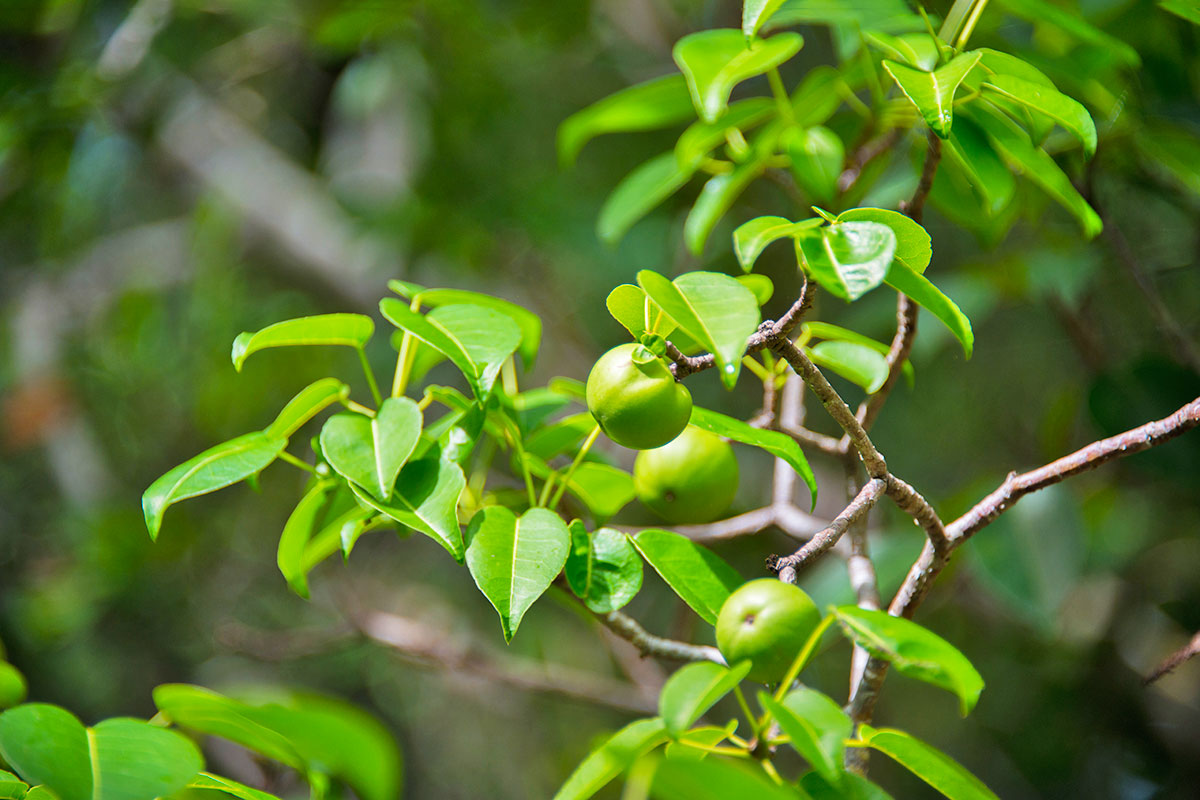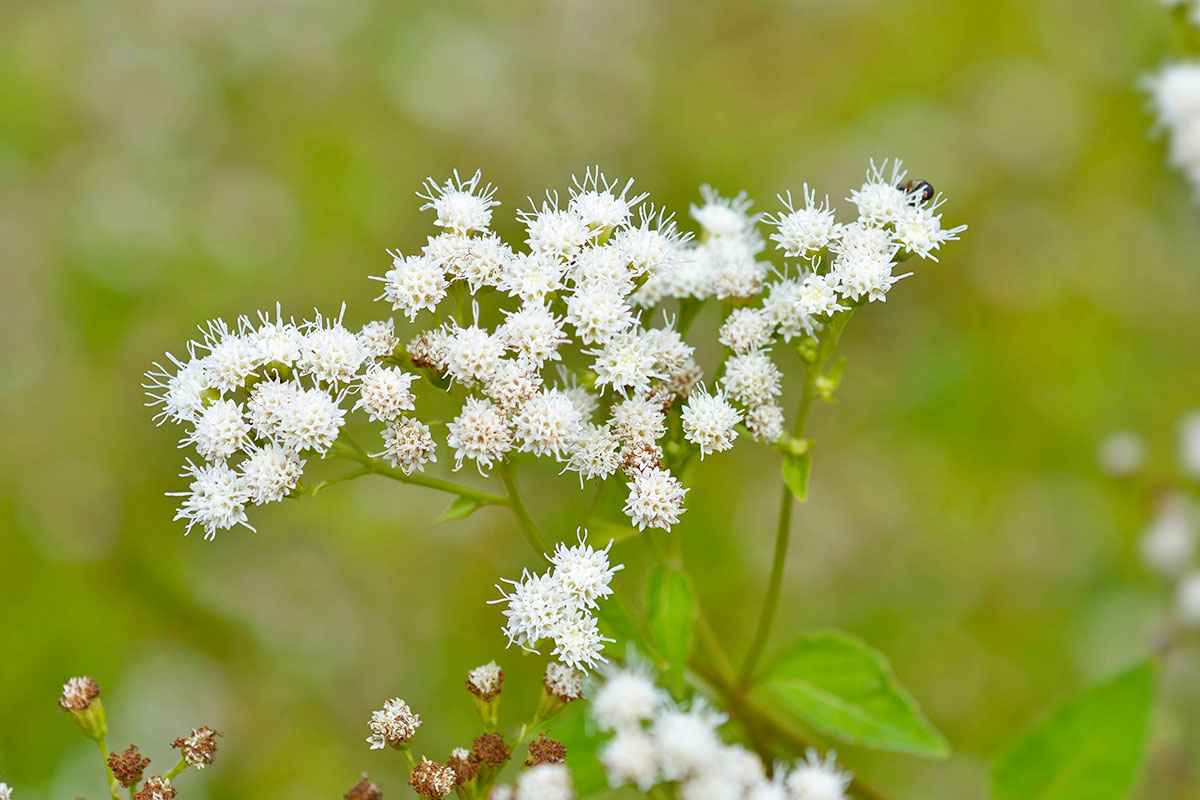
Manchineel Tree (Hippomane mancinella)
The manchineel is officially the world’s deadliest tree. Found amid mangrove forests in the Caribbean, Central America, and the Florida Keys, the machineel produces sap that can cause severe blisters and blindness if it comes into contact with one’s skin or eyes. Rainwater dripping from its leaves, or smoke wafting from its burning wood, can induce sores and pain in mucus membranes. Its applelike fruit is also extremely toxic.
An account published in the medical journal BMJ described a man’s experience of accidentally eating a manchineel fruit: “We noticed a strange peppery feeling in our mouths, which gradually progressed to a burning, tearing sensation and tightness of the throat. The symptoms worsened over a couple of hours until we could barely swallow solid food because of the excruciating pain … Recounting our experience to the locals elicited frank horror and incredulity, such was the fruit’s poisonous reputation.”

Rosary Pea (Abrus precatorius)
The rosary pea gets its name from the frequent use of its dried berries as rosary beads, as well as in jewelry and even children’s toys. Though native to tropical Asia, the woody vine has been cultivated as an ornamental plant in Florida and Hawaii and is now considered invasive. Its shiny red seeds, uniform in size and each crowned with a black dot, produce a deadly toxin called abrin; ingesting one seed is enough to kill you. Other symptoms of Abrus precatorius poisoning include bloody diarrhea, internal bleeding, nausea, severe vomiting, and abdominal pain.

Castor Bean (Ricinus communis)
Another highly toxic plant grown as an ornamental, castor bean features star-shaped leaves in greenish-bronze hues and small scarlet flowers on upright stalks, making it an exotic addition to gardens — despite being the source of ricin, one of the world’s deadliest poisons. All parts of the plant are toxic: Touching its leaves can cause painful skin rashes, while chewing the seeds or inhaling powdered seeds releases the poison. Numerous countries have used (or attempted to use) ricin in espionage or warfare. The U.S. military investigated its efficacy as a chemical weapon during both World Wars, and in 1978, an assassin — possibly a Soviet operative — injected a Bulgarian dissident writer with a ricin pellet on London’s Waterloo Bridge. The victim died four days later.
More Interesting Reads

White Snakeroot (Ageratina altissima)
White snakeroot, a native wildflower with crowns of small white blooms on leafy stems, is found in meadows, backyards, pastures, and wooded areas across the eastern United States. It can grow almost anywhere, which makes it a particularly dangerous plant to humans. Livestock such as cows and goats can eat the poisonous leaves and root systems of the plant and pass a toxin called tremetol to the humans who drink their milk. Among early settlers, tremetol poisoning was known as milk sickness, the trembles, the staggers, or puking fever, among other colorful colloquialisms. Its symptoms included muscle tremors, weakness, cardiac myopathy, and difficulty breathing that often led to death. Nancy Hanks Lincoln, Abraham Lincoln’s mother, died of milk sickness in 1818.

Poison Hemlock (Conium maculatum)
Aptly named poison hemlock — which is actually part of the carrot family — closely resembles wild parsnip and parsley, so it may not be surprising that most cases of poisoning occur when foragers mistake the toxic plant for one of the edible ones. Its purple-spotted stems, leaves, seeds, and clusters of small white flowers contain a toxin called coniine that, when eaten, affects the nervous system and causes respiratory paralysis, eventually leading to death. It was used to execute prisoners in ancient Greece, the most famous victim being the philosopher Socrates in 399 BCE. Though it’s native to Europe (and elsewhere), poison hemlock was imported to the U.S. in the 19th century as an ornamental “fern” and is now found growing wild across the U.S. Poison hemlock is often confused with its even deadlier cousins, western water hemlock (Cicuta douglasii) and spotted water hemlock (Cicuta maculata), both of which are native to North America.

Deadly Nightshade (Atropa belladonna)
The name of this dangerous plant’s genus comes from Atropos, one of the three Fates in Greek mythology, who presided over death. Deadly nightshade contains tropane alkaloids that, if consumed, disrupt the body’s ability to regulate heart rate, blood pressure, digestion, and other involuntary processes, resulting in convulsions and death. This quality made it a handy tool for offing Roman emperors and Macbeth’s enemies. The effects of deadly nightshade poisoning are said to include sensations of flying, suggesting that the plant was the source of alleged witches’ “flying ointment” in early modern European folklore. Ironically, deadly nightshade is also the source of atropine, a drug used to treat low heart rate and even counteract the effects of eating toxic mushrooms.

Opium Poppy (Papaver somniferum)
Papaver somniferum produces opium, the source of morphine, heroin, oxycodone, codeine, and other narcotics — in other words, some of the most addictive substances on Earth. Opium poppies have been cultivated for medicinal purposes since at least 2100 BCE, according to a Sumerian clay tablet that is believed to contain the world’s oldest prescriptions, including one for opium. The Greek physicians Dioscorides and Galen, as well as the Muslim physician Avicenna, also wrote about opium’s therapeutic qualities. Opium-derived laudanum was the Victorian choice for calming crying babies, soothing headaches, or overcoming insomnia; in the U.K., its widespread use led to addiction crises dubbed “morphinomania” until laws restricted the sale of opium in the early 20th century. Today, it’s not a good idea to grow opium poppies even for ornamental purposes: The Drug Enforcement Administration even pressured Monticello’s gardeners to cease cultivation of Thomas Jefferson’s historical poppy plots in the early 1990s.











